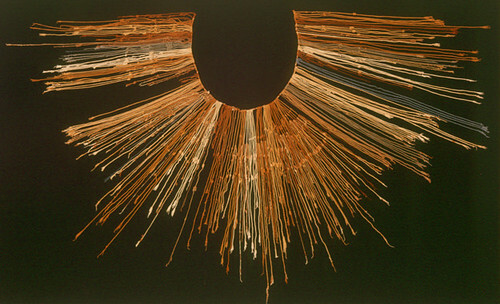Knot Your Average Writing System
September 16 2020
What’s this you’re looking at? A fancy necklace, perhaps?
Nope.
That, friends, is a 15th-century government document.
We used to think the Inca couldn’t write. It turns out they could, just not in a way we would readily recognize. Instead of writing with symbols inked or carved on a surface, they wrote with knots on strings. The style of writing and storing information shown in the picture is called a khipu (aka a quipu).
What they were for
This intricate and ingenious method of communication was used by the Incas and a few other Andean cultures to store all sorts of information: meticulously detailed censuses, tax obligations, accounts, livestock, land measurements, military organization, poems and stories, and even as letters delivered by post.
How they worked
Khipus range wildly in intricacy, from being just a few short strands to having hundreds of long strands. The knots themselves each had meaning. How they were tied and how far apart from one another they were mattered just as much as the colour of the knot and where on the khipu it was located. This means a khipu, especially an intricate one, couldn’t be made off the cuff. It took painstaking planning and preparation to map out exactly what the end result would look like before you could so much as tie your first knot. Khipus also came with oral information so you could better remember what the stored data was about. The stories that went with each khipu were memorized by khipu-keepers (khipu librarians, if you will) called khipu kamayuq.
Khipus nowadays
This way of recordkeeping is old, dating possibly as far back as 3,000 BCE. Quipus were widely used until the 17th century. They’re still used in some areas of the Andes to keep track of livestock and ceremonial reasons, but their use is limited compared to what it used to be.
Alas, old quipus are hard to come by. The reason for this is twofold. First came a mass quipu-burning by Incan Emperor Atawalpa. When he took power, he sought to destroy the historical record regarding the reign of his bitter rival and half-brother, Waskhar. Then even more quipus were thrown in the flames when the Conquistadors took power. (They feared and mistrusted the information stored in the quipus.)
Khipus’ connection to Canada
Khipus are considered to be a sister communication system to the North American Wampum communication method. Wampums, unlike khipus, are traditionally made with shell beads and in horizontal rows. Like with khipus, their use is now limited in comparison to how they were previously used. Historically, they have been used for storytelling, as ceremonial gifts, and for recording important treaties and historical events. If the name “wampum” sounds familiar it is likely due to you having heard about the Two Row Wampum Treaty belt in history class.
Want to learn more about khipus? Check out the Khipu Database Project website!

